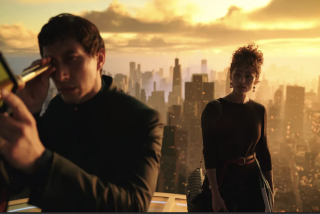The Apocalyptic Truth
It was the spring of 1976 and Eleanor Coppola was accompanying her Oscar-winning director husband, Francis, and their three children to the Philippines for the filming of his ambitious Vietnam war epic “Apocalypse Now,” based on Joseph Conrad’s novella “Heart of Darkness.”
Uprooted from her life as a professional designer, Eleanor Coppola felt, she recalled, like a “woman isolated from my friends, my affairs and my projects.” But that changed just a couple of weeks into the trip, when her husband asked her to film a documentary on the making of “Apocalypse Now.”
“United Artists wanted a team to shoot a five-minute teaser for TV to let people know the film was coming out,” she said. “Francis felt so overwhelmed with just the logistics, he told U.A. he would get it from his in-house people. He felt I could get five minutes sooner or later.”
Coppola ended up with slightly more than five minutes. His wife shot more than 60 hours of footage during their 18 months in the Philippines. The rolls of film sat for 11 years. Finally they have been pared down, for “Hearts of Darkness: A Filmmaker’s Apocalypse,” a documentary airing Saturday on Showtime.
The 90-minute film meshes Eleanor Coppola’s footage with new interviews with the Coppolas and the cast and crew of “Apocalypse Now.” Fax Bahr and George Hickenlooper wrote and directed the documentary, which garnered raves this spring at the Cannes Film Festival.
During the production, Eleanor Coppola said: “I was just trying to meet each day and get through it. In retrospect, it comes clear the theme of the (documentary) is the heroic force of the creative experience and just Francis pushing through every difficulty and not turning back--his determination, that creative force to fulfill his own vision and see his project through.”
“Hearts of Darkness” chronicles how “Apocalypse Now” turned into a nightmare and how it nearly destroyed its director. Originally scheduled to take 16 weeks to shoot, “Apocalypse Now” dragged on for 238 shooting days.
Coppola and his crew faced unpredictable weather, a raging Philippine civil war and rampant drug use on the set. Two weeks into production, Coppola replaced leading man Harvey Keitel with Martin Sheen, who was smoking and drinking heavily and had a massive heart attack during the filming (chronicled in the documentary).
In a shocking moment in “Hearts of Darkness,” Coppola confesses to Eleanor he wants to kill himself because he believes the film is a disaster.
Eleanor Coppola doesn’t recall exactly when the stress began to take its toll.
“That kind of realization creeps up on you,” she said. “We started in March and expected to be done by September, and then in September we expected to be done by Thanksgiving. Along about March of the second year, time and pressure had started to wear on everyone. Martin Sheen had a heart attack and Francis just kind of collapsed one day.”
Witnessing her husband’s anguish over the months was unbearably painful for her. Writing was her salvation.
“I wrote this book (“Notes,” published in 1979). The act of writing something down and putting it on a page kind of placed it somewhere. I didn’t have friends to talk to and ‘Notes’ began to be in the form of letters that I would send back to friends. They would say, ‘Send me more.’ That would keep me going.”
A lot of “powerful and painful” private moments weren’t shot. There’s no mention in the film of her husband’s extramarital affair (included in “Notes”) during the filming.
“That was one of the reasons Francis allowed me to shoot it,” Eleanor Coppola said. “He knew instinctively if something really drastic happened I would drop my camera and run over to him. I wouldn’t stay there to document it. There were many days I didn’t shoot or take my camera out there. I would be in the role of the wife.”
She did tape-record private conversations with her husband. “I didn’t know how useful it would be, but I tried to do everything,” Eleanor Coppola said. “Francis just talked at all these different odd moments and I would just throw the tape recorder down. It wasn’t hidden, but he was so far into his own concerns, he didn’t care if I taped it or not.”
After the production wrapped and the Coppolas returned to their home in San Francisco in 1978, Eleanor Coppola did try to edit the material. “One group wanted the film to be used as a selling tool for the European market,” she said. “There was another faction that wanted me to make a film from the point of view of the wife. So we decided to put it away. There was no real reason to get this footage out.”
Two years ago, Bahr and producer George Zaloom approached the Coppolas about allowing them to turn the footage into a film.
“(Bahr) brought in a writer and an associate to help him and they were determined,” Eleanor Coppola said. “They wanted to see it completed.”
When her husband saw “Hearts of Darkness,” she said, he wasn’t “pleased with everything. But one of the things he had to say is that it’s true.” And she agreed: “It’s all true. It’s the kind of truth we don’t often see in this business, which is a business of illusion. So to see a bit of truth about the illusion, I think, is edifying.”
“Hearts of Darkness: A Filmmaker’s Apocalypse” premieres Saturday at 10 p.m. on Showtime . It repeats Oct. 18 at 9 p.m. , Oct. 22 at 11:45 p.m. and Oct. 29 at 2:10 a.m.
Witnessing her husband’s anguish while making “Apocalypse Now” was painful for Eleanor
More to Read
Only good movies
Get the Indie Focus newsletter, Mark Olsen's weekly guide to the world of cinema.
You may occasionally receive promotional content from the Los Angeles Times.











